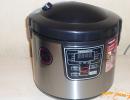Preparing rolls at home step by step with photos
Until recently, rolls in our country were considered exotic. Now you can buy them literally at every step. Moreover, you can make just one call and after a while the finished sushi will be delivered directly to your home. And, looking at these works of Japanese cuisine, few people think that rolls are not at all difficult to prepare yourself at home.
Ingredients:
How to cook rice for rolls at home
1. Everything is very simple, the main thing is to follow the cooking technology. Pour 1 cup of rice into 1.5 cups of cool water, cover the pan with a lid and bring to a boil. Immediately after boiling, (try to open the lid as little as possible, do not stir!) Reduce heat to medium level (closer to minimum) and cook for 5 minutes. Next, reduce the heat to low and leave for another 12 minutes. Remove the pan from the heat, do not open the lid for 15 minutes. The rice for the rolls is ready. It will not boil, will not burn and will be quite sticky.
 2
. Next, you need to season the rice with a special filling. Pour 1 tbsp into a mug. l rice vinegar.
2
. Next, you need to season the rice with a special filling. Pour 1 tbsp into a mug. l rice vinegar.
 3
. Add 1 tsp sugar + half a teaspoon salt. Stir until dissolved.
3
. Add 1 tsp sugar + half a teaspoon salt. Stir until dissolved.
 4
. Now pour the rice in a thin layer and mix it with the dressing. It may seem that this amount of filling is not enough, but it is not.
4
. Now pour the rice in a thin layer and mix it with the dressing. It may seem that this amount of filling is not enough, but it is not.
How to make homemade rolls, option No. 1
 1
. The mat can be wrapped in cling film, since in this version of preparing homemade rolls, the rice is on the outer layer and can get stuck between the rods of the bamboo mat. If you don't have a mat, use a regular kitchen towel, also wrapped in cling film.
1
. The mat can be wrapped in cling film, since in this version of preparing homemade rolls, the rice is on the outer layer and can get stuck between the rods of the bamboo mat. If you don't have a mat, use a regular kitchen towel, also wrapped in cling film.
 2
. Place the nori sheet on the mat, smooth, shiny side down. Depending on the size of the desired rolls, you can cut the sheet in half.
2
. Place the nori sheet on the mat, smooth, shiny side down. Depending on the size of the desired rolls, you can cut the sheet in half.
 3
. Spread the rice in a thin layer over the rough surface of the sheet, leaving a free edge of 1-1.5 cm. To prevent the rice from sticking too much to your hands, moisten your fingers with rice vinegar.
3
. Spread the rice in a thin layer over the rough surface of the sheet, leaving a free edge of 1-1.5 cm. To prevent the rice from sticking too much to your hands, moisten your fingers with rice vinegar.
 4
. Then we carefully take the edges of the nori sheet in the place where there is no rice and turn it over so that the smooth side of the seaweed is on top and the rice is on the bottom.
4
. Then we carefully take the edges of the nori sheet in the place where there is no rice and turn it over so that the smooth side of the seaweed is on top and the rice is on the bottom.
 5
. Lay out a thin strip of fresh cucumber. Dense cucumbers do not need to be peeled or seeds removed. Just cut the cucumber into long strips as is.
5
. Lay out a thin strip of fresh cucumber. Dense cucumbers do not need to be peeled or seeds removed. Just cut the cucumber into long strips as is.
 6
. Then place cottage cheese (a substitute for Philadelphia cheese) in a strip near the cucumber.
6
. Then place cottage cheese (a substitute for Philadelphia cheese) in a strip near the cucumber.
 7
. On the other side of the cucumber, lay out a strip of red fish.
7
. On the other side of the cucumber, lay out a strip of red fish.
 8
. We twist the rolls, starting from the edge where there is no rice. Gradually, lifting the mat, roll the nori sheet with the filling into a tight roll. You can give it a round or square shape as desired.
8
. We twist the rolls, starting from the edge where there is no rice. Gradually, lifting the mat, roll the nori sheet with the filling into a tight roll. You can give it a round or square shape as desired.
 9
. Roll the roll in sesame seeds. Cut into 6-8 pieces. It is important to cut the rolls beautifully, the knife must be very sharp. You can also pre-lubricate the blade with rice vinegar.
9
. Roll the roll in sesame seeds. Cut into 6-8 pieces. It is important to cut the rolls beautifully, the knife must be very sharp. You can also pre-lubricate the blade with rice vinegar.

Rolls at home, option No. 2
 1
. Place a sheet of nori, smooth side down. Spread the rice by wetting your fingers in the rice vinegar. Leave a free edge of the sheet. On top, at a distance of 1.5 cm from the edge of the rice, place strips of cucumber and fish.
1
. Place a sheet of nori, smooth side down. Spread the rice by wetting your fingers in the rice vinegar. Leave a free edge of the sheet. On top, at a distance of 1.5 cm from the edge of the rice, place strips of cucumber and fish.
 2
. Roll up the roll.
2
. Roll up the roll.
 3
. Spread cream cheese on top.
3
. Spread cream cheese on top.
 4
. Then roll the roll in sesame seeds. Cut into 6-8 pieces with a sharp knife.
4
. Then roll the roll in sesame seeds. Cut into 6-8 pieces with a sharp knife.
Delicious homemade rolls are ready
Bon appetit!

What are rolls made from?
 In Japan, making rolls has long been elevated to the level of an art. Every little detail is taken into account here. But real masters are especially careful when choosing products. They should not only be fresh, but also complement each other well, creating a real harmony of taste in the mouth. So before you start making your own rolls, you need to select all the necessary ingredients correctly.
In Japan, making rolls has long been elevated to the level of an art. Every little detail is taken into account here. But real masters are especially careful when choosing products. They should not only be fresh, but also complement each other well, creating a real harmony of taste in the mouth. So before you start making your own rolls, you need to select all the necessary ingredients correctly.
Rice
Not every type of rice is suitable for making rolls. In order not to bother too much, you can simply purchase special varieties of Japanese rice. Now they are sold in the specialized department of almost any chain store. Of course, such a product is not very cheap.
In fact, regular rice is also suitable for rolls, which costs much less than special rice. The main thing is that the rice is moderately sticky, but not too overcooked. Therefore, the best option is to buy round-grain varieties, and the best of them is ordinary Krasnodar round rice. What you really shouldn't do is buy clear and parboiled rice.
Wasabi
What we don’t have problems with in our stores is wasabi. True, in our country you can only buy a cheap imitation of this seasoning. Not every Japanese can afford real wasabi even in their homeland. The main components of the imitation are horseradish and mustard, flavored with several other ingredients. It's not exactly wasabi, of course, but it tastes very much like it.
Just a tip: it’s better to buy the seasoning in powder. This wasabi just needs to be diluted with water and the seasoning is ready. Ready-made wasabi in tubes can also be used for rolls, but the likelihood of them containing various not very healthy preservatives is much higher.
Rice vinegar
To make the rolls tasty, you shouldn’t skimp on vinegar. For this dish, it is best to use Japanese rice vinegar, the so-called sou. Unlike our sour and rather hot vinegar, sou has a pleasant, slightly sweet taste. Plus, it's not spicy at all.
Nori
An integral ingredient for rolls are sheets of seaweed or, in other words, nori. They are sold in the form of large dark sheets. Their sizes vary, but the most optimal width for such a sheet is considered to be 20 cm or so.
Ginger and soy sauce
Rolls, of course, can be made without these two ingredients, but serving them without pickled ginger (gari) and soy sauce is somehow wrong.
As a rule, rolls are eaten dipped in soy sauce. By and large, there is not much difference which variety of sauces to buy. The main thing is that it is a product of natural fermentation and that it is packaged in glass containers. For everything else, you can completely rely on your taste.
As for ginger, there is nothing complicated here either. You just need to make sure that the product is fresh. Yes, and one more nuance. Ginger comes in white and pink. For lovers of spicy food, it is better to take pink ginger, while others should take white ginger. Although in reality the taste of ginger does not really matter. After all, it is eaten in order to remove the taste sensations from the just eaten roll before putting the next one in the mouth.
Some subtleties
 Making rolls has its own subtleties. Professional craftsmen also have their own tricks. But at first you can get by with standard rules, especially since there aren’t very many of them.
Making rolls has its own subtleties. Professional craftsmen also have their own tricks. But at first you can get by with standard rules, especially since there aren’t very many of them.
How to cook rice properly
How to choose rice has already been written above. Now some nuances of preparing and cooking cereals.
First, you need to wash the rice. First, you just need to fill it with water and shake it a little with your hands to clear it of debris and husks. Even if the rice is clean, the water will still turn milky white. This water must be drained, then again “squeeze” the cereal with massaging movements, add water and repeat the entire operation. You need to do this 5-7 times. This will be quite enough for the water to remain clear after the procedure.
Rice must be cooked in a fairly deep pan. Water should be poured at the rate of 1 part rice to 1.5 parts water. Cook the cereal over low heat. When the rice has absorbed all the water, the rice should be removed from the heat and left to steep under the lid closed for about 15 minutes. Only after this can the rice for rolls be considered ready.
Filling and dressing for rolls
Cooking rice is half the battle. It still needs to be refueled. To make the dressing, mix salt, sugar and vinegar. In this case, the sou (rice vinegar) can be heated a little, then the seasonings will dissolve faster.
The rice that has not yet cooled down should be placed in a fairly wide container. Gently pour the resulting dressing mixture into the rice in a thin stream over a wooden spatula, stirring constantly with the same spatula. It is advisable to stir the rice with horizontal movements so that each grain is saturated with the dressing mixture. Then cover the container with a paper towel and leave for a while.
Now you can start filling. Most often, fish is used as such in rolls, which is cut into thin and long slices. If other products are used for the filling, then, as a rule, they also need to be cut into strips.
How to roll rolls?

The simplest version of homemade rolls is hoso maki or thin rolls. Of course, to prepare them you need to get a special bamboo mat - makisu.
First, you need to place the mat on the table and prepare a bowl with a mixture of water and vinegar to wet your hands. Place half a sheet of nori on the mat. Place it with the rough side up. Place four tablespoons of rice on the seaweed. The spoons should be full - heaped. With your hands soaked in water and vinegar, you need to spread the rice over the surface of the nori sheet so that there is a free strip about 10 mm wide on top, and about 5 mm on the bottom. The result should be a layer of rice approximately 7 mm thick.
There is no point in talking about laying out the filling. It is simply laid out in layers or paths on the rice. But then the most interesting part begins - rolling the roll. Doing this is not as difficult as it seems at first glance. First, you need to align the bottom edge of the nori sheet with the edge of the mat. Holding the filling, lift the makisa and begin to roll the roll blank with forward and upward movements. When the roll is rolled to the end, the edges of the mat should be slightly bent and the roll should be rolled back and forth a little. There is no need to put pressure on him. After this procedure, the workpiece can be considered ready.
How to cut rolls?
Cutting rolls into even rolls is also a kind of art. This is best done following the traditions of Japanese roll-making masters. First, you need to moisten the knife with a mixture of water and vinegar. This kind of “lubricant” will allow the knife to pass through rice as if through butter. The prepared roll must be cut first in the middle, and then each part should be divided into three or four equal rolls. That, in fact, is the whole trick.
Popular roll recipes
There are incredibly many types of rolls. There are simple recipes, there are complex ones, there are popular ones, and there are unfamiliar ones. In principle, you can make anything at home. It’s better to start with the simplest or, at least, popular varieties.
Syake maki rolls
 Perhaps these are the simplest rolls that even a child can make in Japan. All they need is rice, nori and salmon prepared according to the recipe described above. Sake maki is incredibly easy to make. To do this, you need to lay rice on half a sheet of nori in a layer 5-7 mm thick, departing from the edge by about 1 cm. In this case, it is meant that not the entire area of the seaweed sheet is filled with rice, but only half of it. A “path” of salmon cut into oblong pieces is laid out in the middle of the layer of rice. After this, the workpiece is rolled into a roll and then cut into 8-16 rolls.
Perhaps these are the simplest rolls that even a child can make in Japan. All they need is rice, nori and salmon prepared according to the recipe described above. Sake maki is incredibly easy to make. To do this, you need to lay rice on half a sheet of nori in a layer 5-7 mm thick, departing from the edge by about 1 cm. In this case, it is meant that not the entire area of the seaweed sheet is filled with rice, but only half of it. A “path” of salmon cut into oblong pieces is laid out in the middle of the layer of rice. After this, the workpiece is rolled into a roll and then cut into 8-16 rolls.
By the way, you can make rolls with shrimp or crab meat using the same principle. The only caveat is that the peeled shrimp must first be fried in oil for 5 minutes, and then simmered with a small amount of soy sauce (you can add a little sherry) until the liquid has completely evaporated.
Philadelphia rolls
 Preparing this type of rolls, of course, cannot do without rice, nori and rice vinegar. For the filling you will need the following ingredients:
Preparing this type of rolls, of course, cannot do without rice, nori and rice vinegar. For the filling you will need the following ingredients:
- red fish;
- cucumber;
- Philadelphia cream cheese (you can use another similar cream cheese).
There is no point in describing the preparation of rice in this case. This is discussed in sufficient detail in the previous sections.
Place a sheet of nori divided in half on a bamboo mat and place a thin layer of rice on it (about 4 tablespoons). Using the mat to help yourself, turn the nori over so the rice is facing down and place it back on the mat. Grease the shiny side of the seaweed sheet with Philadelphia cheese, and place thin slices of cucumber on it. After this, you need to roll the roll using the above method.
Place the roll blank on the edge of the mat, and place a layer of thinly sliced red fish in front of it. The width should correspond to the resulting roll, and the length should be such as to cover the entire rice. Using a mat, “wrap” the roll blank with red fish and roll it lightly.
It remains to cut the roll first in half, and then each part into another 3 or 4 parts. Philadelphia rolls are ready.
Rolls "California"
 The birthplace of this type of roll is not Japan, but the United States. In principle, that is why they are called “California”. To prepare them you will need quite a lot of additional ingredients, in addition to rice, vinegar and seaweed leaves:
The birthplace of this type of roll is not Japan, but the United States. In principle, that is why they are called “California”. To prepare them you will need quite a lot of additional ingredients, in addition to rice, vinegar and seaweed leaves:
- trout;
- avocado;
- cucumber;
- curd cheese;
- Flying fish roe (tobiko). If you couldn’t find tobiko in the supermarket, you can also take cod or pollock caviar. True, such rolls will taste different from real California.
The technology for preparing “California” is in many ways similar to that used when working with “Philadelphia”. After all, both types of rolls are turned inside out, i.e. in finished products, nori is located not outside, but inside the mini-roll.
To begin with, rice is laid out on half a sheet of seaweed. A thin layer of caviar is placed on top of it. Now the sheet of nori with the filling should be turned over with the caviar down, and its smooth surface should be greased with a thin layer of cheese. Next, lay out thin slices of avocado, cucumber and trout. After this, the workpiece can be rolled into a roll, given a more square shape using a mat and cut into 6 or 8 rolls.
These rolls can be slightly modified by using mayonnaise sauce (preferably Japanese) instead of cheese and crab meat instead of trout or together with it.
Hot Tempura rolls
 Rolls can be served not only in “raw” form. Even in Japan, this dish is often fried or baked. Rice for such rolls is prepared in the same way as for all other varieties. And besides this, you will also need nori for Tempura:
Rolls can be served not only in “raw” form. Even in Japan, this dish is often fried or baked. Rice for such rolls is prepared in the same way as for all other varieties. And besides this, you will also need nori for Tempura:
- cream cheese;
- lightly salted salmon or salmon;
- cucumber;
- flying fish caviar;
- egg;
- tempura flour;
- breadcrumbs.
Place the rice on the nori and generously spread it with cream cheese. Spread flying fish roe evenly on top and place fish and cucumber cut into strips. Roll the workpiece into a roll.
Now you need to prepare the batter by mixing the egg with tempura flour in a long rectangular container. The last product can be bought, but you can also prepare it yourself. To do this, mix wheat and rice flour, starch, garlic powder, black pepper and baking powder.
The prepared roll should be dipped in batter, rolled in breading and fried on all sides in vegetable oil heated in a frying pan. Only after this, cut the workpiece into 6 pieces and serve immediately.
***
That's all. Of course, there are countless varieties and recipes of rolls in the world. But they are all done according to the principles described above. Well, you can experiment with fillings, adding those ingredients that you like best. Bon appetit!
Video recipes






